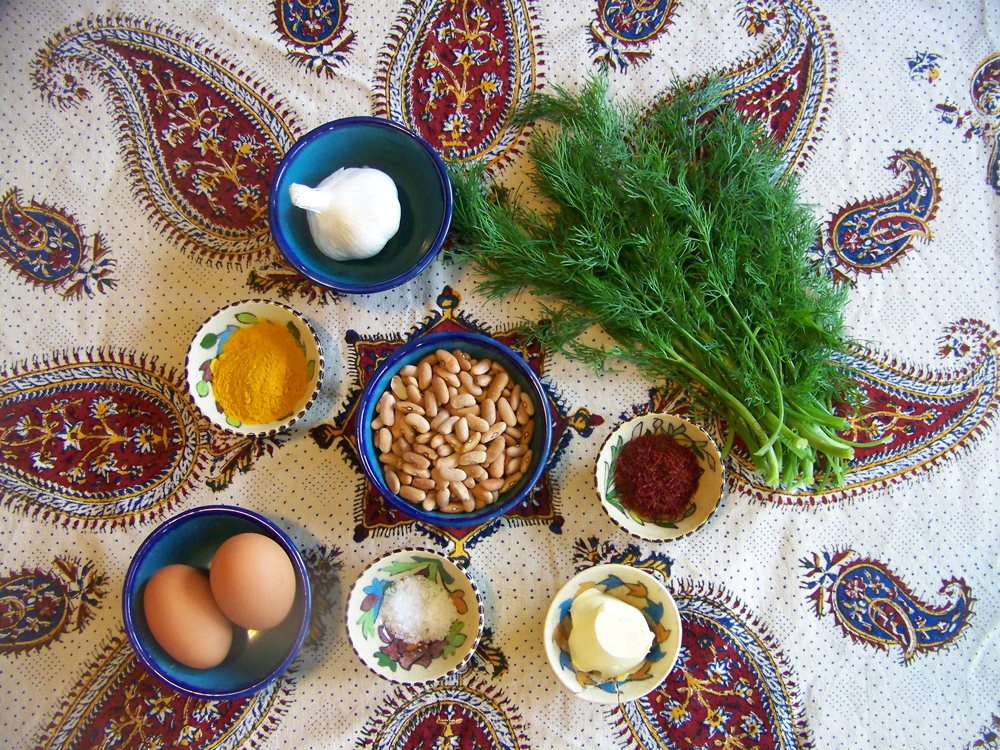Sara Saljoughi

Or baghala ghatogh, as it is called in Gilaki, a dialect spoken in the northern Iranian province of Gilan. I have never heard anyone say the name of this dish without emphasis. One offers baghali ghatogh with a proud tone, or an air of expectation that tests the recipient’s palate. Even when it is served as one part of a collection of dishes, its name is never prattled off from a list. Baghali ghatogh is a robust stew of the bean pacha baghala, butter, garlic, and dill. The bean is difficult to find in North America—I have a freezer full of unpeeled pacha baghala that traveled with me from my last trip to Iran—but in the past I have had success using fresh fava beans or (frozen) lima beans.
Baghali ghatogh demands that one rethink how time ought to be spent. This dish distracts from the very notion of time: it forces focus on peeling the skin of each bean. Every memory I have of eating this dish or making it conjures an image of three very large bowls: one with the unpeeled beans, one with discarded peels, and one with the prepared, exposed beans. The bowls are always in the middle of a busy room, and many hands tend to them. Anyone who eats baghali ghatogh knows this and thus does not expect to find it on generic Tehran menus with run of the mill kabob or ghormeh sabzi. The poached egg with a slightly runny yolk that crowns each serving of the dish is a reminder of the duration of care it demands, right until the moment of serving.
Each time I make this, I aim for a more fully set stew. A watery rendition is to be avoided at all costs.
Serves 4–6
INGREDIENTS
1 pound fresh or frozen pacha baghali, shelled and peeled or fava beans (fresh or frozen), or lima beans (fresh or frozen)
5–6 Tablespoons butter
6–8 cloves garlic, minced or 4 stalks green garlic, including scapes
1–2 bunches (or 3 cups) fresh dill, finely chopped
2 teaspoons turmeric
salt and pepper to taste
1⁄4 teaspoon ground saffron (prepared by grinding threads with a pinch of sugar in a mortar and pestle) steeped in
2 Tablespoons of hot water
1 egg per person
INSTRUCTIONS
Heat butter in a heavy pot or deep skillet, making sure that it does not brown. Add garlic and sauté for 1 minute. Stir in the beans and dill. Cook for 3 minutes. Be careful not to break the beans as you stir. Add the turmeric and salt. Cook for another 2 minutes. Add saffron water. Add 2–3 cups of water to the pot until the beans are covered. Bring the stew to a boil and then reduce the heat so that the beans are simmering very gently. Partially cover the pot with a lid and cook until the beans are tender. After 20 minutes, taste the stew and add salt if necessary. At this point, if your stew is not thick enough, you may need to reduce the heat, add a bit more butter, adjust the seasoning, and cook longer. If you do this, treat the beans ever so gingerly. Once you are ready to serve, crack one egg per person into the stew, making sure to leave space between the eggs. It will take about 3–4 minutes for the egg white to set. Season the egg with salt and pepper and serve immediately. This dish is best eaten with basmati rice, a side of smoked fish, and pickled vegetables, preferably garlic. Noushe jan!












